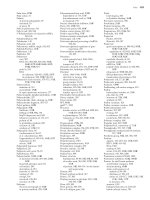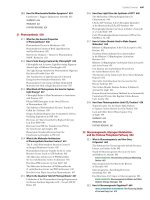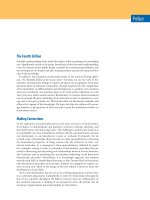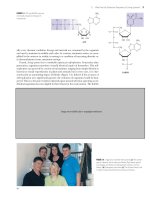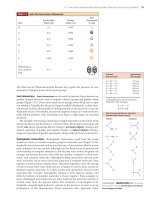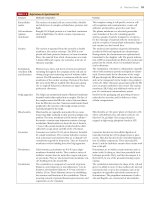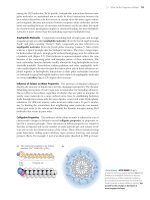Biochemistry, 4th Edition P28 ppt
Bạn đang xem bản rút gọn của tài liệu. Xem và tải ngay bản đầy đủ của tài liệu tại đây (355.35 KB, 10 trang )
8.7 What Are Steroids, and What Are Their Cellular Functions? 233
8.7 What Are Steroids, and What Are Their
Cellular Functions?
Cholesterol
A large and important class of terpene-based lipids is the steroids. This molecu-
lar family, whose members affect an amazing array of cellular functions, is based
on a common structural motif of three 6-membered rings and one 5-membered
ring all fused together. Cholesterol (Figure 8.16) is the most common steroid in
animals and the precursor for all other animal steroids. The numbering system
for cholesterol applies to all such molecules. Many steroids contain methyl
groups at positions 10 and 13 and an 8- to 10-carbon alkyl side chain at position
17. The polyprenyl nature of this compound is particularly evident in the side
chain. Many steroids contain an oxygen at C-3, either a hydroxyl group in sterols
or a carbonyl group in other steroids. Significantly, the carbons at positions 10
and 13 and the alkyl group at position 17 are nearly always oriented on the same
side of the steroid nucleus, the -orientation. Alkyl groups that extend from the
other side of the steroid backbone are in an ␣-orientation.
Cholesterol is a principal component of animal cell plasma membranes, and
smaller amounts of cholesterol are found in the membranes of intracellular or-
ganelles. The relatively rigid fused ring system of cholesterol and the weakly polar
alcohol group at the C-3 position have important consequences for the properties
of plasma membranes. Cholesterol is also a component of lipoprotein complexes in
the blood, and it is one of the constituents of plaques that form on arterial walls in
atherosclerosis.
Steroid Hormones Are Derived from Cholesterol
Steroids derived from cholesterol in animals include five families of hormones (the
androgens, estrogens, progestins, glucocorticoids, and mineralocorticoids) and bile
acids (Figure 8.17). Androgens such as testosterone and estrogens such as estradiol
mediate the development of sexual characteristics and sexual function in animals.
The progestins such as progesterone participate in control of the menstrual cycle
and pregnancy. Glucocorticoids (cortisol, for example) participate in the control of
carbohydrate, protein, and lipid metabolism, whereas the mineralocorticoids regu-
late salt (Na
ϩ
, K
ϩ
, and Cl
Ϫ
) balances in tissues. The bile acids (including cholic and
deoxycholic acid) are detergent molecules secreted in bile from the gallbladder that
assist in the absorption of dietary lipids in the intestine.
HO
AB
CD
1
2
3
4
5
H
3
C
19
9
10 8
7
6
11
12
H
3
C
18
13
17
14
16
15
CH
2
CH
3
HC
CH
2
CH
2
CH
3
CH
3
HC
20 21
22
23
24
25
26
27
Cholesterol
FIGURE 8.16 The structure of cholesterol, shown with
steroid ring designations and carbon numbering.
234 Chapter 8 Lipids
8.8 How Do Lipids and Their Metabolites Act
as Biological Signals?
Glycerophospholipids and sphingolipids play important structural roles as the prin-
cipal components of biological membranes (see Chapter 9). However, their modi-
fication and breakdown also produce an eclectic assortment of substances that act
as powerful chemical signals (Figures 8.18 and 8.19). In contrast to the steroid hor-
mones (Figure 8.17), which travel from tissue to tissue in the blood to exert their
effects, these lipid metabolites act locally, either within the cell in which they are
made or on nearby cells. Signal molecules typically initiate a cascade of reactions
with multiple possible effects, and the lifetimes of these powerful signals in or near
a cell are usually very short. Thus, the creation and breakdown of signal molecules
is almost always carefully timed and regulated.
HO
C
CH
2
OH
OH
O
Cortisol
OH
Testosterone
O
Progesterone
O
C
CH
3
O
HO
OH
Estradiol
O
Cholic acid
HO OH
HO
COOH
Deoxycholic acid
HO
HO
COOH
FIGURE 8.17 The structures of several important
sterols derived from cholesterol.
Phospholipase D
Phospholipase C
Phospholipase A
2
Phospholipase A
1
O
–
OP
O
OCH
2
CH
2
N
+
CH
3
CH
3
CH
3
O
CH
2
CH
2
CH
2
O
O
C
O
C
(b)
FIGURE 8.18 (a) Phospholipases A
1
and A
2
cleave fatty acids from a glycerophospholipid, producing lyso-
phospholipids. Phospholipases C and D hydrolyze on either side of the phosphate in the polar head group.
(b) Phospholipases are components of the venoms of many poisonous snakes.The pain and physiological
consequences of a snake bite partly result from breakdown of cell membranes by phospholipases.
© Joe McDonald/CORBIS
© Tom Bean/CORBIS
(a)
Diamondback rattlesnake
Indian cobra
8.8 How Do Lipids and Their Metabolites Act as Biological Signals? 235
Enzymes known as phospholipases hydrolyze the ester bonds of glycerophos-
pholipids as shown in Figure 8.18. Phospholipases A
1
and A
2
remove fatty acid
chains from the 1- and 2-positions of glycerophospholipids, respectively. Phospholi-
pases C and D attack the polar head group of a glycerophospholipid. Hydrolysis of
inositol phospholipids by phospholipase C produces a diacylglycerol and inositol-
1,4,5-trisphosphate (IP
3
) (Figure 8.19), two signal molecules whose combined ac-
tions trigger signaling cascades that regulate many cell processes (see Chapter 32).
Action of phospholipase A
2
on a phosphatidic acid releases a fatty acid and a
lysophosphatidic acid (LPA, Figure 8.19). If the fatty acid is arachidonic acid, fur-
ther chemical modifications can produce a family of 20-carbon compounds—that
is, eicosanoids. The eicosanoids are local hormones produced as a response to in-
jury and inflammation. They exert their effects on cells near their sites of synthesis
(see Chapter 24). LPA produced outside the cell is a signal that can bind to recep-
tor proteins on nearby cells, thereby regulating a host of processes, including brain
development, cell proliferation and survival, and olfaction (the “sense of smell”).
Sphingolipids can also be modified or broken down to produce chemical signals.
Sphingosine itself can be phosphorylated to produce sphingosine-1-phosphate
(S1P) inside cells (Figure 8.20). S1P may either exert a variety of intracellular effects
or may be excreted from the cell, where it can bind to membrane receptor proteins,
either on adjacent cells or on the cell from which the S1P was released. Excreted
A DEEPER LOOK
Glycerophospholipid Degradation: One of the Effects of Snake Venom
The venoms of poisonous snakes contain (among other things) a
class of enzymes known as phospholipases, enzymes that cause
the breakdown of phospholipids. For example, the venoms of the
eastern diamondback rattlesnake (Crotalus adamanteus) and the
Indian cobra (Naja naja) both contain phospholipase A
2
, which
catalyzes the hydrolysis of fatty acids at the C-2 position of glyc-
erophospholipids (Figure 8.18). The phospholipid breakdown
product of this reaction, lysolecithin, acts as a detergent and dis-
solves the membranes of red blood cells, causing them to rupture.
Indian cobras kill several thousand people each year.
Lysophosphatidic acid (LPA)
(extracellular)
Arachidonic acid
EffectsProstaglandins
Thromboxanes
Leukotrienes
Effects
Phosphatidic acid
PLA
2
+ Phosphatidylinositol-4,5-bisphosphate (PIP
2
)
PLC
Inositol-1,4,5-trisphosphate (IP
3
)Diacylglycerol
Increase in
cellular Ca
2
+
Activation of
protein kinase C
Binding and
regulation
Phosphorylation
in signaling
pathways
Phosphatidylinositol
2 ADP
2 ATP
FIGURE 8.19 Modification and breakdown of glycerophospholipids produce a variety of signals and regulatory
effects. Phospholipase A
2
cleaves a fatty acid from phosphatidic acid to produce lysophosphatidic acid
(LPA), which can act as an extracellular signal. If the fatty acid released is arachidonic acid, it can be the
substrate for synthesis of prostaglandins, thromboxanes, and leukotrienes.Phospholipase C action on
phosphatidylinositol-4,5-bisphosphate produces diacylglycerol and inositol-1,4,5-trisphosphate, two signal
molecules that work together to active protein kinases—enzymes that phosphorylate other proteins in
signaling pathways.
236 Chapter 8 Lipids
HUMAN BIOCHEMISTRY
Plant Sterols and Stanols—Natural Cholesterol Fighters
Dietary guidelines for optimal health call for reducing the choles-
terol intake. One strategy involves eating plant sterols and stanols
in place of cholesterol-containing fats such as butter (figure). De-
spite their structural similarity to cholesterol, minor isomeric dif-
ferences and the presence of methyl and ethyl groups in the side
chains of these substances result in their poor absorption by in-
testinal mucosal cells. Interestingly, stanols are even less well ab-
sorbed than their sterol counterparts. Both sterols and stanols
bind to cholesterol receptors on intestinal cells and block the ab-
sorption of cholesterol itself. Stanols esterified with long-chain
fatty acids form micelles (see page 244) that are more effectively
distributed in the fat phase of the food digest and provide the
most effective blockage of cholesterol uptake. (Stanols are fully re-
duced sterols.) Raisio Group, a Finnish company, has developed
Benecol, a stanol ester spread that can lower LDL cholesterol by
up to 14% if consumed daily (see graph). McNeil Nutritionals has
partnered with Raisio Group to market Benecol in the United
States.
Cholesterol (mg/dL)
Ϫ202468101214
Study period (mo)
Sitostanol-ester margarine
200
240
230
220
210
250
H
3
C
H
3
C
CH
3
CH
3
CH
2
CH
3
Stigmasterol
HO
H
3
C
H
3
C
H
3
C
CH
3
CH
3
CH
2
CH
3
Stigmastanol
-Sitosterol
HO
H
3
C
H
3
C
H
3
C
CH
3
CH
3
CH
3
-Sitostanol
HO
H
3
C
H
3
C
H
3
C
CH
3
CH
3
CH
3
HO
H
3
C
H
H
ᮤ
Serum cholesterol levels before and after the con-
sumption of margarine with and without sitostanol
ester for 12 months. Green circles: 0 g/day. Red
squares: 2.6 g/day. Blue triangles: 1.8 g/day. Note: The
y-axis begins at 200 mg cholesterol/dL. (Adapted from
Miettinen, T. A., et al., 1995. Reduction of serum cholesterol with
sitostanol-ester margarine in a mildly hypercholesterolemic population.
New England Journal of Medicine 333:1308–1312.)
8.9 What Can Lipidomics Tell Us about Cell,Tissue, and Organ Physiology? 237
S1P binds to many different receptor proteins and provokes many different cell and
tissue effects, among them inflammation in allergic reactions, heart rate, and move-
ment and migration of certain cells. Sphingolipid signal molecules are carefully bal-
anced and regulated in organisms, and chemical agents that disturb this balance
can be highly toxic. For example, fumonisin is a common fungal contaminant of
corn and corn-based products that inhibits sphingolipid biosynthesis (Figure 8.20;
see also Chapter 24). Fumonisin can trigger esophageal cancer in humans and leu-
coencephalomalacia, a fatal neurological disease in horses.
8.9 What Can Lipidomics Tell Us about Cell, Tissue,
and Organ Physiology?
The crucial role of lipids in cells is demonstrated by the large number of human
diseases that involve the disruption of lipid metabolic enzymes and pathways. Ex-
amples of such diseases include atherosclerosis, diabetes, cancer, infectious dis-
eases, and neurodegenerative diseases. Emerging analytical techniques are making
possible the global analysis of lipids and their interacting protein partners in
organs, cells, and organelles—an approach termed lipidomics. A typical cell may
contain more than a thousand different lipids, each with a polar head and a hydro-
phobic tail or tails. Despite this general similarity, proteins recognize lipids with
exquisite specificity. Local concentrations of lipids vary between organelles and be-
tween specific areas of cellular membranes.
Complete understanding of lipid function, as well as alteration of such function
in disease states, will require the determination of which lipids are present and in
OH
C
H
H
C
+
NH
3
OPO
3
2
–
CH
2
C
C
H
H
Sphingosine-1-phosphate (S1P)
CH
3
CH
3
CH
3
CH
3
NH
2
O
O
OH
OH OH
OHOOC
OHOOC
HOOC
HOOC
Fumonisin B
1
FIGURE 8.20 Structures of sphingosine-1-phosphate
(S1P) and fumonisin B
1
.
238 Chapter 8 Lipids
what concentrations in every intracellular location. The same knowledge will be
needed about each lipid’s interaction partners. Mass spectrometric analyses of rat
heart muscle reveal that the onset of diabetes results in dramatic changes in triglyc-
eride levels, an increase in phosphatidylinositol levels, and a decrease in phos-
phatidylethanolamine. On the other hand, mass spectrometric analyses of brain
white matter in the very early stages of Alzheimer’s disease show a dramatic decrease
in one type of plasmalogen and a threefold increase in ceramide levels.
Cellular lipidomics provides a framework for understanding the myriad roles of
lipids, which include (but are not limited to) membrane transport (see Chapter 9),
metabolic regulation (see Chapters 18–27), and cell signaling (see Chapter 32). For
example, six different classes of lipids have been shown to modulate systems im-
portant in the regulation of pain responses. Each of these classes of lipids exerts its
action by interacting with one or more receptor proteins. True understanding of
the molecular basis for diseases and metabolic and physiologic conditions may re-
quire comprehensive and simultaneous analyses of many lipid species and their re-
spective receptors.
HUMAN BIOCHEMISTRY
17-Hydroxysteroid Dehydrogenase 3 Deficiency
Testosterone, the principal male sex steroid hormone, is synthe-
sized in five steps from cholesterol, as shown in the following fig-
ure. In the last step, five isozymes catalyze the 17-hydroxysteroid
dehydrogenase reaction that interconverts 4-androstenedione and
testosterone. Defects in the synthesis or action of testosterone can
impair the development of the male phenotype during embryoge-
nesis and cause the disorders of human sexuality termed male
pseudohermaphroditism. Specifically, mutations in isozyme 3 of
the 17-hydroxysteroid dehydrogenase in the fetal testes impair
the formation of testosterone and give rise to genetic males with
female external genitalia and blind-ending vaginas. Such individ-
uals are typically raised as females but virilize at puberty, due to an
increase in serum testosterone, and develop male hair growth pat-
terns. Fourteen different mutations of 17-hydroxysteroid dehy-
drogenase 3 have been identified in 17 affected families in the
United States, the Middle East, Brazil, and western Europe. These
families account for about 45% of the patients with this disorder
reported in scientific literature.
HO HO
C
H
O
O
O
O
O
O
OH
O
O
O
OH
Cholesterol
Pregnenolone
17␣-Hydroxyprogesterone
4-Androstenedione
Testosterone
Progesterone
Desmolase
(Mitochondria)
(Endoplasmic
reticulum)
17␣-Hydroxylase
17,20-Lyase
(Gonads)
17-Hydroxysteroid
dehydrogenase
Isocaproic aldehyde
H
3
C
H
3
C
H
3
C
H
3
C
H
3
C
H
3
C
H
3
C
H
3
C
H
3
C
H
3
C
H
3
C
H
3
C
SUMMARY
Lipids are a class of biological molecules defined by low solubility
in water and high solubility in nonpolar solvents. As molecules that
are largely hydrocarbon in nature, lipids represent highly reduced
forms of carbon and, upon oxidation in metabolism, yield large
amounts of energy. Lipids are thus the molecules of choice for meta-
bolic energy storag e. The lipids found in biological systems are either
hydrophobic (containing only nonpolar groups) or amphipathic
(containing both polar and nonpolar groups). The hydrophobic na-
ture of lipid molecules allows membranes to act as effective barriers
to more polar molecules.
8.1 What Are the Structures and Chemistry of Fatty Acids? A fatty
acid is composed of a long hydrocarbon chain (“tail”) and a terminal
carboxyl group (“head”). The carboxyl group is normally ionized un-
der physiological conditions. Fatty acids occur in large amounts in bi-
ological systems but only rarely in the free, uncomplexed state. They
typically are esterified to glycerol or other backbone structures.
8.2 What Are the Structures and Chemistry of Triacylglycerols? A sig-
nificant number of the fatty acids in plants and animals exist in the form
of triacylglycerols (also called triglycerides). Triacylglycerols are a major
energy reserve and the principal neutral derivatives of glycerol found in
animals. These molecules consist of a glycerol esterified with three fatty
acids. Triacylglycerols in animals are found primarily in the adipose tis-
sue (body fat), which serves as a depot or storage site for lipids. Monoa-
cylglycerols and diacylglycerols also exist, but they are far less common
than the triacylglycerols.
8.3 What Are the Structures and Chemistry of Glycerophospholipids?
A 1,2-diacylglycerol that has a phosphate group esterified at carbon
atom 3 of the
glycerol backbone is a glycerophospholipid, also known as
a phosphoglyceride or a glycerol phosphatide. These lipids form one of
the largest and most important classes of natural lipids. They are essen-
tial components of cell membranes and are found in small concentra-
tions in other parts of the cell. All glycerophospholipids are members of
the broader class of lipids known as phospholipids.
8.4 What Are Sphingolipids, and How Are They Important for Higher
Animals? Sphingolipids represent another class of lipids in biological
membranes. An 18-carbon amino alcohol, sphingosine, forms the back-
bone of these lipids rather than glycerol. Typically, a fatty acid is joined
to a sphingosine via an amide linkage to form a ceramide. Sphingo-
myelins are a phosphorus-containing subclass of sphingolipids espe-
cially important in the nervous tissue of higher animals. A sphingo-
myelin is formed by the esterification of a phosphorylcholine or a
phosphorylethanolamine to the 1-hydroxy group of a ceramide. Glyco-
sphingolipids are another class of ceramide-based lipids that, like the
sphingomyelins, are important components of muscle and nerve mem-
branes in animals. Glycosphingolipids consist of a ceramide with one or
more sugar residues in a -glycosidic linkage at the 1-hydroxyl moiety.
8.5 What Are Waxes, and How Are They Used? Waxes are esters of
long-chain alcohols with long-chain fatty acids. The resulting molecule
can be viewed (in analogy to the glycerolipids) as having a weakly polar
head group (the ester moiety itself) and a long, nonpolar tail (the
hydrocarbon chains). Fatty acids found in waxes are usually saturated.
The alcohols found in waxes may be saturated or unsaturated and may
include sterols, such as cholesterol. Waxes are water insoluble due to
their predominantly hydrocarbon nature.
8.6 What Are Terpenes, and What Is Their Relevance to Biological
Systems? The terpenes are a class of lipids formed from combinations
of two or more molecules of 2-methyl-1,3-butadiene, better known as
isoprene (a five-carbon unit abbreviated C
5
). A monoterpene (C
10
) con-
sists of two isoprene units, a sesquiterpene (C
15
) consists of three iso-
prene units, a diterpene (C
20
) has four isoprene units, and so on. Iso-
prene units can be linked in terpenes to form straight-chain or cyclic
molecules, and the usual method of linking isoprene units is head to
tail. Monoterpenes occur in all higher plants, whereas sesquiterpenes
and diterpenes are less widely known.
8.7 What Are Steroids, and What Are Their Cellular Functions? A
large and important class of terpene-based lipids is the steroids. This
molecular family, whose members affect an amazing array of cellular
functions, is based on a common structural motif of three 6-membered
rings and one 5-membered ring all fused together. Cholesterol is the
most common steroid in animals and the precursor for all other animal
steroids. The numbering system for cholesterol applies to all such mol-
ecules. The polyprenyl nature of this compound is particularly evident
in the side chain. Many steroids contain an oxygen at C-3, either a hy-
droxyl group in sterols or a carbonyl group in other steroids. The
methyl groups at positions 10 and 13 and the alkyl group at position
17 are usually oriented on the same side of the steroid nucleus, the
-orientation. Alkyl groups that extend from the other side of the
steroid backbone are in an ␣-orientation. Cholesterol is a principal com-
ponent of animal cell plasma membranes. Steroids derived from cho-
lesterol in animals include five families of hormones (the androgens,
estrogens, progestins, glucocorticoids, and mineralocorticoids) and
bile acids.
8.8 How Do Lipids and Their Metabolites Act as Biological Signals?
Modification and breakdown of cellular lipids produce an eclectic as-
sortment of substances that act as powerful chemical signals. Signal mol-
ecules typically initiate a cascade of reactions with multiple possible ef-
fects. The creation and breakdown of signal molecules is almost always
carefully timed and regulated. Phospholipases initiate the production of
a variety of lipid signals, including arachidonic acid (the precursor
to eicosanoids), lysophosphatidic acid, inositol-1,4,5-trisphosphate, and
diacylglycerol.
8.9 What Can Lipidomics Tell Us about Cell, Tissue, and Organ Physi-
ology? The comprehensive analysis of lipids and their interacting
protein partners in organs, cells, and organelles is termed lipidomics.
A typical cell may contain more than a thousand different lipids. Com-
plete understanding of lipid function, as well as alteration of such func-
tion in disease states, will require the determination of which lipids are
present and in what concentrations in every intracellular location. The
same knowledge will be needed about each lipid’s interaction partners.
Problems 239
PROBLEMS
Preparing for an exam? Create your own study path for this
chapter at www.cengage.com/login
1. Draw the structures of (a) all the possible triacylglycerols that can
be formed from glycerol with stearic and arachidonic acid and
(b) all the phosphatidylserine isomers that can be formed from
palmitic and linolenic acids.
2. Describe in your own words the structural features of
a. a ceramide and how it differs from a cerebroside.
b. a phosphatidylethanolamine and how it differs from a phos-
phatidylcholine.
c. an ether glycerophospholipid and how it differs from a plas-
malogen.
240 Chapter 8 Lipids
d. a ganglioside and how it differs from a cerebroside.
e. testosterone and how it differs from estradiol.
3. From your memory of the structures, name
a. the glycerophospholipids that carry a net positive charge.
b. the glycerophospholipids that carry a net negative charge.
c. the glycerophospholipids that have zero net charge.
4. Compare and contrast two individuals, one whose diet consists
largely of meats containing high levels of cholesterol and the other
whose diet is rich in plant sterols. Are their risks of cardiovascular
disease likely to be similar or different? Explain your reasoning.
5. James G. Watt, Secretary of the Interior (1981–1983) in Ronald Rea-
gan’s first term, provoked substantial controversy by stating publicly
that trees cause significant amounts of air pollution. Based on your
reading of this chapter, evaluate Watt’s remarks.
6. In a departure from his usual and highly popular westerns, author
Louis L’Amour wrote a novel in 1987, Last of the Breed (Bantam
Press), in which a military pilot of Native American ancestry is shot
down over the former Soviet Union and is forced to use the survival
skills of his ancestral culture to escape his enemies. On the rare
occasions when he is able to trap and kill an animal for food, he
selectively eats the fat, not the meat. Based on your reading of this
chapter, what is his reasoning for doing so?
7. As you read Section 8.7, you might have noticed that phospholipase
A
2
, the enzyme found in rattlesnake venom, is also the enzyme that
produces essential and beneficial lipid signals in most organisms. Ex-
plain the differing actions of phospholipase A
2
in these processes.
8. Visit a grocery store near you, stop by the rodent poison section,
and examine a container of warfarin or a related product. From
what you can glean from the packaging, how much warfarin would
a typical dog (40 lbs) have to consume to risk hemorrhages and/or
death?
9. Refer to Figure 8.13 and draw each of the structures shown and try
to identify the isoprene units in each of the molecules. (Note that
there may be more than one correct answer for some of these mol-
ecules, unless you have the time and facilities to carry out
14
C la-
beling studies with suitable organisms.)
10. (Integrates with Chapter 3.) As noted in the Deeper Look box on
polar bears, a polar bear may burn as much as 1.5 kg of fat resources
per day. What weight of seal blubber would you have to ingest if you
were to obtain all your calories from this energy source?
11. If you are still at the grocery store working on problem 8, stop by
the cookie shelves and choose your three favorite cookies from
the shelves. Estimate how many calories of fat, and how many
other calories from other sources, are contained in 100 g of each
of these cookies. Survey the ingredients listed on each package,
and describe the contents of the package in terms of (a) satu-
rated fat, (b) cholesterol, and (c) trans fatty acids. (Note that
food makers are required to list ingredients in order of decreas-
ing amounts in each package.)
12. Describe all of the structural differences between cholesterol and
stigmasterol.
13. Describe in your own words the functions of androgens, glucocorti-
coids, and mineralocorticoids.
14. Look through your refrigerator, your medicine cabinet, and your
cleaning solutions shelf or cabinet, and find at least three commer-
cial products that contain fragrant monoterpenes. Identify each
one by its scent and then draw its structure.
15. Our ancestors kept clean with homemade soap (page 222), often
called “lye soap.” Go to />and read the procedure for making lye soap from vegetable oils and
lye (sodium hydroxide). What chemical process occurs in the mak-
ing of lye soap? Draw reactions to explain. How does this soap work
as a cleaner?
16. Mayonnaise is mostly vegetable oil and vinegar. So what’s the essen-
tial difference between oil and vinegar salad dressing and mayon-
naise? Learn for yourself: Combine a half cup of pure vegetable oil
(olive oil will work) with two tablespoons of vinegar in a bottle, cap
it securely, and shake the mixture vigorously. What do you see? Now
let the mixture sit undisturbed for an hour. What do you see now?
Add one egg yolk to the mixture, and shake vigorously again. Let
the mixture stand as before. What do you see after an hour? After
two hours? Egg yolk is rich in phosphatidylcholine. Explain why the
egg yolk caused the effect you observed.
17. The cholesterol-lowering benefit of stanol-ester margarine is only
achieved after months of consumption of stanol esters (see graph,
page 236). Suggest why this might be so. Suppose dietary sources
represent approximately 25% of total serum cholesterol. Based on
the data in the graph, how effective are stanol esters at preventing
uptake of dietary cholesterol?
18. Statins are cholesterol-lowering drugs that block cholesterol syn-
thesis in the human liver (see Chapter 24). Would you expect the
beneficial effects of stanol esters and statins to be duplicative or ad-
ditive? Explain.
19. If most plant-derived food products contain plant sterols and
stanols, would it be as effective (for cholesterol-lowering purposes)
to simply incorporate plant fats in one’s diet as to use a sterol- or
stanol-fortified spread like Benecol? Consult a suitable reference
(for example, />#sources at the Linus Pauling Institute) to compose your answer.
20. Tetrahydrogestrinone is an anabolic steroid. It was banned by the
U.S. Food and Drug Administration in 2003, but it has been used il-
legally since then by athletes to increase muscle mass and strength.
Nicknamed “The Clear,” it has received considerable attention in
high-profile steroid-abuse cases among athletes such as baseball
player Barry Bonds and track star Marion Jones. Use your favorite
Web search engine to learn more about this illicit drug. How is it
synthesized? Who is “the father of prohormones” who first synthe-
sized it? Why did so many prominent athletes use The Clear (and its
relative, “The Cream”) when less expensive and more commonly
available anabolic steroids are in common use? (Hint: There are at
least two answers to this last question.)
Preparing for the MCAT Exam
21. Make a list of the advantages polar bears enjoy from their nonpolar
diet. Why wouldn’t juvenile polar bears thrive on an exclusively
nonpolar diet?
22. Snake venom phospholipase A
2
causes death by generating
membrane-soluble anionic fragments from glycerophospholipids.
Predict the fatal effects of such molecules on membrane proteins
and lipids.
OH
O
Tetrahydrogestrinone
H
H
FURTHER READING
General
Robertson, R. N., 1983. The Lively Membranes. Cambridge: Cambridge
University Press.
Seachrist, L., 1996. A fragrance for cancer treatment and prevention.
The Journal of NIH Research 8:43.
Vance, D. E., and Vance, J. E. (eds.), 1985. Biochemistry of Lipids and Mem-
branes. Menlo Park, CA: Benjamin/Cummings.
Sterols
Anderson, S., Russell, D. W., and Wilson, J. D., 1996. 17-Hydroxysteroid
dehydrogenase 3 deficiency. Trends in Endocrinology and Metabolism
7:121–126.
DeLuca, H. F., and Schneos, H. K., 1983. Vitamin D: Recent advances.
Annual Review of Biochemistry 52:411–439.
Denke, M. A., 1995. Lack of efficacy of low-dose sitostanol therapy as an
adjunct to a cholesterol-lowering diet in men with moderate hyper-
cholesterolemia. American Journal of Clinical Nutrition 61:392–396.
Thompson, G., and Grundy, S., 2005. History and development of plant
sterol and stanol esters for cholesterol-lowering purposes. American
Journal of Cardiology 96:3D–9D.
Vanhanen, H. T., Blomqvist, S., Ehnholm, C., et al., 1993. Serum cho-
lesterol, cholesterol precursors, and plant sterols in hypercholes-
terolemic subjects with different apoE phenotypes during dietary
sitostanol ester treatment. Journal of Lipid Research 34:1535–1544.
Isoprenes and Prenyl Derivatives
Dowd, P., Ham, S W., Naganathan, S., and Hershline, R., 1995. The
mechanism of action of vitamin K. Annual Review of Nutrition 15:
419–440.
Hirsh, J., Dalen, J. E., Deykin, D., Poller, L., and Bussey, H., 1995. Oral
anticoagulants: Mechanism of action, clinical effectiveness, and op-
timal therapeutic range. Chest 108:231S–246S.
Sharkey, T. D., 1995. Why plants emit isoprene. Nature 374:769.
Sharkey, T. D., 1996. Emission of low molecular-mass hydrocarbons
from plants. Trends in Plant Science 1:78–82.
Eicosanoids
Chakrin, L. W., and Bailey, D. M., 1984. The Leukotrienes—Chemistry and
Biology. Orlando: Academic Press.
Keuhl, F. A., and Egan, R. W., 1980. Prostaglandins, arachidonic acid
and inflammation. Science 210:978–984.
Sphingolipids
Hakamori, S., 1986. Glycosphingolipids. Scientific American 254:44–53.
Trans Fatty Acids
Katan, M. B., Zock, P. L., and Mensink, R. P., 1995. Trans fatty acids and
their effects on lipoproteins in humans. Annual Review of Biochem-
istry 15:473–493.
Lipids of Archaea
Hanford, M., and Peebles, T., 2002. Archaeal tetraetherlipids: Unique
structures and applications. Applied Biochemistry and Biotechnology 97:
45–62.
Lipid Alterations in Disease States
Malan, T. P., and Porreca, F., 2005. Lipid mediators regulating pain sen-
sitivity. Prostaglandins and Other Lipid Mediators 77:123–130.
Smith, L. E. H., and Connor, K. M., 2005. A radically twisted lipid regu-
lates vascular death. Nature Medicine
11:1275–1276.
Lipidomics
Ferrari, C., and Chatgilialoglu, C., 2005. Geometrical trans lipid isomers:
A new target for lipidomics. Chembiochem 6:1722–1734.
German, J., Gillies, L., Smilowitz, J., Zivkovic, A., and W
atkins, S., 2007.
Lipidomics and lipid profiling in metabolomics. Current Opinion in
Lipidology 18:66–71.
Muralikrishna, R., Hatcher, J., and Dempsey, R., 2006. Lipids and
lipidomics in brain injury and diseases. AAPS Journal 8:E314–E321.
Van Meer, G., 2005. Cellular lipidomics. EMBO Journal 24:3159–3165.
Weak, M. R., 2005. The emerging field of lipidomics. Nature Reviews
Drug Discovery 4:594–610.
Lipids as Signaling Molecules
Eyster, K., 2007. The membrane and lipids as integral participants in sig-
nal transduction: Lipid signal transduction for the non-lipid bio-
chemist. Advances in Physiology Education 31:5–16.
Fernandis, A., and Wenk, M., 2007. Membrane lipids as signaling mole-
cules. Current Opinion in Lipidology
18:121–128.
Rosen, H., and Goetzl, E., 2005. Sphingosine-1-phosphate and its re-
ceptors: An autocrine and paracrine network. Nature Reviews Immu-
nology 5:560–570.
Further Reading 241
© Sven Peter/iStockphoto.com
9
Membranes
and Membrane Transport
Membranes are key structural and functional elements of cells. All cells have a cyto-
plasmic membrane, or plasma membrane, that functions (in part) to separate the
cytoplasm from the surroundings. The plasma membrane is also responsible for
(1) the exclusion of certain toxic ions and molecules from the cell, (2) the accu-
mulation of cell nutrients, and (3) energy transduction. It functions in (4) cell loco-
motion, (5) reproduction, (6) signal transduction processes, and (7) interactions
with molecules or other cells in the vicinity.
Even the plasma membranes of prokaryotic cells are complex (Figure 9.1). With
no intracellular organelles to divide and organize the work, bacteria carry out
processes either at the plasma membrane or in the cytoplasm itself. Eukaryotic cells,
however, contain numerous intracellular organelles that perform specialized tasks.
Nucleic acid biosynthesis is handled in the nucleus; mitochondria are the site of
electron transport, oxidative phosphorylation, fatty acid oxidation, and the tricar-
boxylic acid cycle; and secretion of proteins and other substances is handled by the
endoplasmic reticulum (ER) and the Golgi apparatus. This partitioning of labor is
not the only contribution of the membranes in these cells. Many of the processes
occurring in these organelles (or in the prokaryotic cell) actively involve mem-
branes. Thus, some of the enzymes involved in nucleic acid metabolism are mem-
brane associated. The electron transfer chain and its associated system for ATP syn-
thesis are embedded in the mitochondrial membrane. Many enzymes responsible
for aspects of lipid biosynthesis are located in the ER membrane.
This chapter discusses the composition, structure, and dynamic processes of
biological membranes.
9.1 What Are the Chemical and Physical Properties
of Membranes?
Water’s tendency to form hydrogen bonds and share in polar interactions, and the
hydrophobic effect, which promotes self-association of lipids in water to maximize
entropy, are the basis for the interactions of lipids and proteins to form membranes.
These forces drive amphiphilic glycerolipids, sphingolipids, and sterols to form
membrane structures in water, and these forces facilitate the association of proteins
(and thus myriad biological functions) with membranes. A symphony of molecular
events over a range of times from picoseconds to many seconds results in the move-
ment of lipids and proteins across and between membranes; catalyzes reactions at
Frog eggs are macroscopic facsimiles of microscopic
cells. All cells are surrounded by a thin, ephemeral yet
stable membrane.
It takes a membrane to make sense out of disorder
in biology.
Lewis Thomas
The World’s Biggest Membrane,
The Lives of a Cell (1974)
KEY QUESTIONS
9.1 What Are the Chemical and Physical
Properties of Membranes?
9.2 What Are the Structure and Chemistry of
Membrane Proteins?
9.3 How Are Biological Membranes Organized?
9.4 What Are the Dynamic Processes That
Modulate Membrane Function?
9.5 How Does Transport Occur Across
Biological Membranes?
9.6 What Is Passive Diffusion?
9.7 How Does Facilitated Diffusion Occur?
9.8 How Does Energy Input Drive Active
Transport Processes?
9.9 How Are Certain Transport Processes Driven
by Light Energy?
9.10 How Is Secondary Active Transport Driven
by Ion Gradients?
ESSENTIAL QUESTION
Membranes serve a number of essential cellular functions.They constitute the
boundaries of cells and intracellular organelles, and they provide a surface where
many important biological reactions and processes occur. Membranes have proteins
that mediate and regulate the transport of metabolites, macromolecules, and ions.
Hormones and many other biological signal molecules and regulatory agents exert
their effects via interactions with membranes. Photosynthesis, electron transport,
oxidative phosphorylation, muscle contraction, and electrical activity all depend on
membranes and membrane proteins. For example, 30 percent of the genes of
Mycoplasma genitalium are thought to encode membrane proteins.
What are the properties and characteristics of biological membranes that ac-
count for their broad influence on cellular processes and transport?
Create your own study path for
this chapter with tutorials, simulations, animations,
and Active Figures at www.cengage.com/ login
